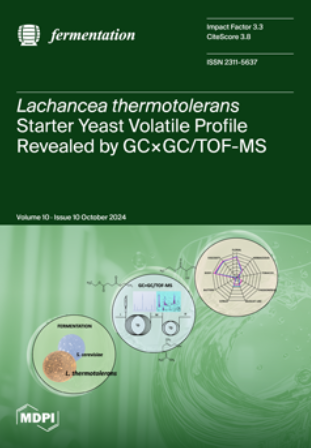Solid State and Semi-Solid Fermentations of Olive and Sunflower Cakes with Yarrowia lipolytica: Impact of Biological and Physical Pretreatments
IF 3.3
3区 农林科学
Q2 BIOTECHNOLOGY & APPLIED MICROBIOLOGY
引用次数: 1
Abstract
Lignocellulosic biomass is a promising feedstock for added value compound production in biotechnological processes such as solid-state fermentation (SSF). Although these solid materials can be directly used as substrates in fermentations in a solid state, a pretreatment is often required, especially if the microorganism selected is unable to produce lignocellulosic enzymes. In the present work, several pretreatment strategies were applied to a 50% (w/w) mixture of olive and sunflower cakes before SSF for lipase production by the oleaginous yeast Yarrowia lipolytica W29. Co-culture strategies with Y. lipolytica and Aspergillus niger did not improve lipase production by the oleaginous yeast. Biological pretreatment with a fungal enzymatic extract led to a significant increase in sugar availability in the substrate mixture after a short incubation period, improving yeast growth. Microwave and ultrasound were the physical pretreatments selected and microwave irradiation proved to be the best method, resulting in 44% and 17% increases in yeast growth and lipase production, respectively, compared to the untreated mixture. An improvement in lipase activity was also observed after ultrasonic treatment in semi-solid fermentations, leading to a 2-fold increase in this enzyme activity compared to the control. The utilization of pretreatments before SSF with Y. lipolytica can increase sugars availability and result in structural changes in the solid substrate, which can improve the bioprocesses’ productivity.用解脂亚罗维菌固态和半固态发酵橄榄和向日葵蛋糕:生物和物理预处理的影响
木质纤维素生物质是固体发酵(SSF)等生物技术过程中一种很有前途的附加值化合物生产原料。尽管这些固体材料可以在固态发酵中直接用作底物,但通常需要预处理,特别是在所选微生物不能产生木质纤维素酶的情况下。在本工作中,在由含油酵母Yarrowia lipolytica W29生产脂肪酶的SSF之前,将几种预处理策略应用于50%(w/w)的橄榄和向日葵饼的混合物。与解脂酵母和黑曲霉的共培养策略并不能提高含油酵母的脂肪酶产量。真菌酶提取物的生物预处理导致在短培养期后底物混合物中的糖有效性显著增加,从而改善酵母生长。选择微波和超声波进行物理预处理,微波辐射被证明是最好的方法,与未处理的混合物相比,酵母生长和脂肪酶产量分别增加44%和17%。在半固态发酵中超声处理后,还观察到脂肪酶活性的改善,导致该酶活性比对照增加2倍。在用溶脂酵母进行SSF之前利用预处理可以增加糖的可用性,并导致固体底物的结构变化,这可以提高生物过程的生产率。
本文章由计算机程序翻译,如有差异,请以英文原文为准。
求助全文
约1分钟内获得全文
求助全文
来源期刊

Fermentation-Basel
BIOTECHNOLOGY & APPLIED MICROBIOLOGY-
CiteScore
3.80
自引率
18.90%
发文量
594
审稿时长
7 weeks
期刊介绍:
Fermentation-Basel is an international open access journal published by MDPI, focusing on fermentation-related research, including new and emerging products, processes and technologies, such as biopharmaceuticals and biotech drugs. The journal enjoys a good reputation in the academic community and provides a high-impact forum for researchers in the field of bioengineering and applied microbiology.
 求助内容:
求助内容: 应助结果提醒方式:
应助结果提醒方式:


